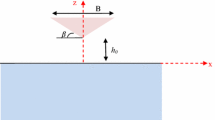Abstract
In this study, the water entry of wedges in regular waves is numerically investigated by a two-dimensional in-house numerical code. The numerical model based on the viscous Navier-Stokes (N-S) equations employs a high-order different method—the constrained interpolation profile (CIP) method to discretize the convection term. A Volume of Fluid (VOF)-type method, the tangent of hyperbola for interface capturing/slope weighting (THINC/SW) is employed to capture the free surface/interface, and an immersed boundary method is adopted to treat the motion of wedges. The momentum source function derived from the Boussinesq equation is applied as an internal wavemaker to generate regular waves. The accuracy of the numerical model is validated in comparison with experimental results in the literature. The results of water entry in waves are provided in terms of the impact force of wedge, velocity and pressure distributions of fluid. Considerable attention is paid to the effects of wave parameters and the position of wedge impacting the water surface. It is found that the existence of waves significantly influences the velocity and pressure field of fluid and impact force on the wedges.
Similar content being viewed by others
References
Abrate, S., 2011. Hull slamming, Applied Mechanics Reviews, 64(6), 060803.
Bunnik, T. and Buchner, B., 2004. Numerical prediction of wave loads on subsea structures in the splash zone, Proceedings of the 14th International Offshore and Polar Engineering Conference, Toulon, France.
Cheng, Y., Ji, C.Y., Zhai, G.J. and Oleg, G., 2018. Numerical investigation of water entry of a wedge into waves with current effects using a fully nonlinear HOBEM, Ocean Engineering, 153, 33–52.
Faltinsen, O., 1993. Sea Loads on Ships and Offshore Structures, Vol. 1, Cambridge University Press, Cambridge.
Hu, C.H. and Kashiwagi, M., 2009. Two-dimensional numerical simulation and experiment on strongly nonlinear wave-body interactions, Journal of Marine Science and Technology, 14(2), 200–213.
Hu, X.Z., Cai, D.J. and Jiang, Y.Y., 2017. A numerical approach to the dynamic response of the deployment system during a circular cylinder crossing through the wave zone, Shock and Vibration, 2017, 7974057.
Liu, B.J., Cheng, D., Sun, Z.C., Zhao, X.Z., Chen, Y. and Lin, W.D., 2019. Experimental and numerical study of regular waves past a submerged breakwater, Journal of Hydrodynamics, 31(4), 641–653.
Liu, X., Lin, P.Z. and Shao, S.D., 2015. ISPH wave simulation by using an internal wave maker, Coastal Engineering, 95, 160–170.
Sun, S.Y., Sun, S.L. and Wu, G.X., 2015. Oblique water entry of a wedge into waves with gravity effect, Journal of Fluids and Structures, 52, 49–64.
Truscott, T.T., Epps, B.P. and Belden, J., 2014. Water entry of projectiles, Annual Review of Fluid Mechanics, 46, 355–378.
Tveitnes, T., Fairlie-Clarke, A.C. and Varyani, K., 2008. An experimental investigation into the constant velocity water entry of wedge-shaped sections, Ocean Engineering, 35(14–15), 1463–1478.
Wagner, H., 1932. Über Stoß — und Gleitvorgänge an der Oberfläche von Flüssigkeiten, ZAMM — Zeitschrift für Angewandte Mathematik und Mechanik, 12(4), 193–215.
Wang W.H. and Wang, Y.Y., 2010. Numerical study on cylinder entering water in wave, Journal of Shanghai Jiaotong University, 44(10), 1393–1399. (in Chinese)
Wei, G., Kirby, J.T. and Sinha, A., 1999. Generation of waves in Boussinesq models using a source function method, Coastal Engineering, 36(4), 271–299.
Worthington, A.M. and Cole, R.S., 1900. IV. Impact with a liquid surface studied by the aid of instantaneous photography. Paper II, Philosophical Transactions of the Royal Society of London. Series A, Containing Papers of a Mathematical or Physical Character, 194(252–261), 175–199.
Yabe, T. and Wang, P.Y., 1991. Unified numerical procedure for compressible and incompressible fluid, Journal of the Physical Society of Japan, 60(7), 2105–2108.
Yabe, T., Xiao, F. and Utsumi, T., 2001. The constrained interpolation profile method for multiphase analysis, Journal of Computational Physics, 169(2), 556–593.
Ye, Z.T., Zhao, X.Z. and Deng, Z.Z., 2016. Numerical investigation of the gate motion effect on a dam break flow, Journal of Marine Science and Technology, 21(4), 579–591.
Zhao, R. and Faltinsen, O., 1993. Water entry of two-dimensional bodies, Journal of Fluid Mechanics, 246, 593–612.
Zhao, X.Z., Ye, Z.T. and Fu, Y.N., 2014a. Green water loading on a floating structure with degree of freedom effects, Journal of Marine Science and Technology, 19(3), 302–313.
Zhao, X.Z., Ye, Z.T., Fu, Y.N. and Cao, F.F., 2014b. A CIP-based numerical simulation of freak wave impact on a floating body, Ocean Engineering, 87, 50–63.
Author information
Authors and Affiliations
Corresponding author
Additional information
Foundation item: This study was partially supported by Foundation of Zhejiang Institute of Hydraulic and Estuary (Grant No. Haian A18003), the Science and Technology Plan Projects of Zhejiang water (Grant No. RB1803), Zhejiang Provincial Natural Science Foundation (Grant Nos. LQ19E090004 and LQ16E090004) and the Science and Technology Plan Projects of Zhejiang Province (Grant No. 2018F10026) and Tang Scholar.
Rights and permissions
About this article
Cite this article
Hu, Zj., Zhao, Xz., Li, My. et al. Numerical Simulation of Water Entry of Wedges in Waves Using A CIP-Based Model. China Ocean Eng 35, 48–60 (2021). https://doi.org/10.1007/s13344-021-0005-4
Received:
Revised:
Accepted:
Published:
Issue Date:
DOI: https://doi.org/10.1007/s13344-021-0005-4




